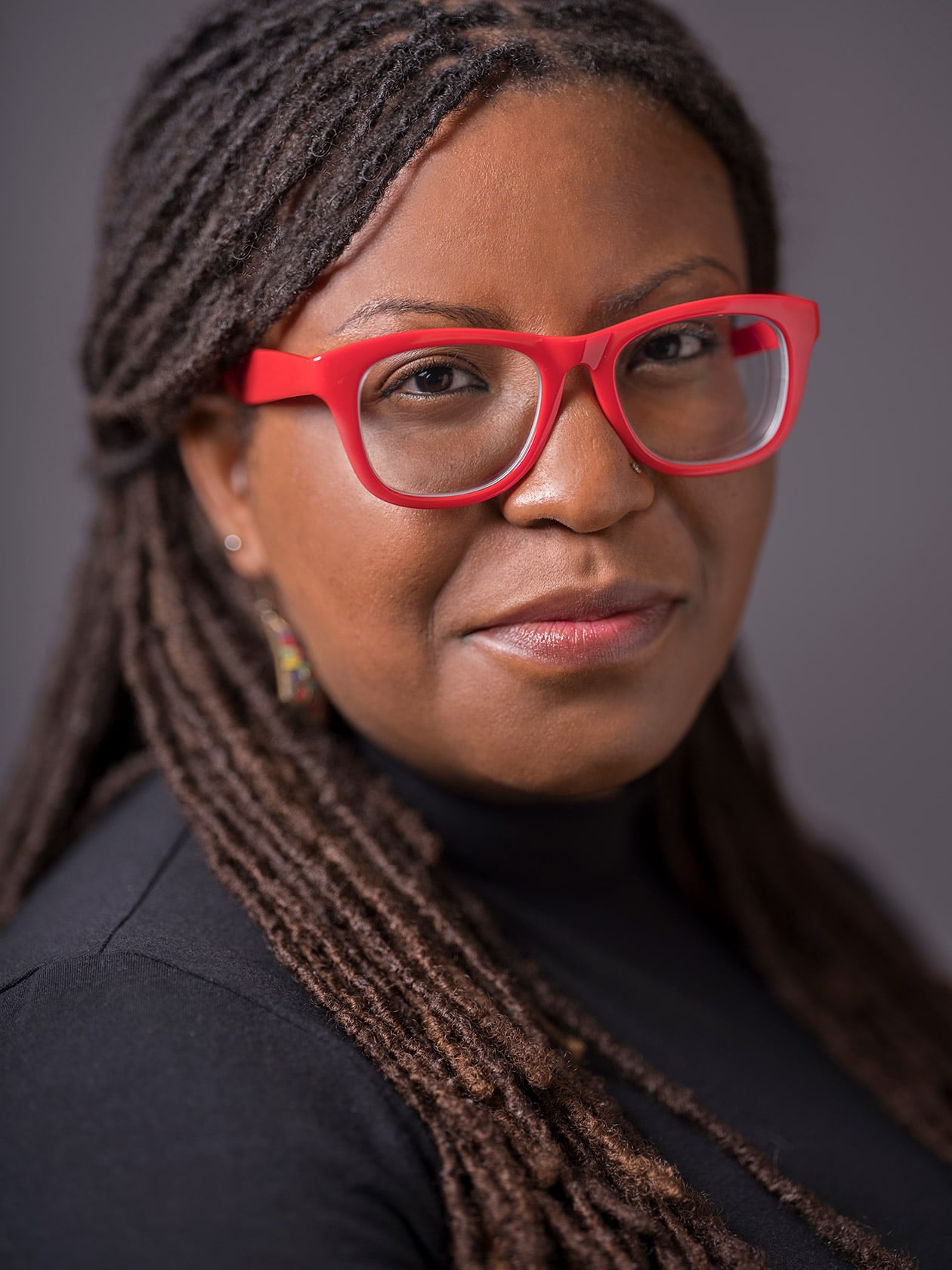Through a Lens, Darkly
Sylvester researcher Dr. Zinzi Bailey is focused on advancing public health through the prism of structural racism
Interview by Bob Woods
Photography by Peter Freed

Zinzi Bailey, Sc.D., M.S.P.H., is a research assistant professor in the Division of Medical Oncology at Sylvester Comprehensive Cancer Center at the Miller School of Medicine. That she was named after Nelson Mandela’s youngest daughter was perhaps a sign of Dr. Bailey’s personal and professional dedication to championing human rights and racial justice that was to come.
Born in Jamaica in 1985, she and her family emigrated to Miami three years later. Beginning in childhood, Dr. Bailey was drawn toward a career in public health, a path nurtured throughout her education, research and publishing endeavors. She has coupled that passion with a focus on structural racism in America, which she views as pervading the nation’s history and culture, and in particular, its health care system.
The fundamental disparities endemic to racism — from slavery to the Jim Crow era to enduring housing and job discrimination — have only been exacerbated during the COVID-19 pandemic, a confluence she and two co-authors examined in an article published in December in the New England Journal of Medicine. Two months later, in The Lancet, Dr. Bailey was among numerous public health and medical experts who jointly wrote an assessment of the Trump Administration’s inequitable health-related policies.
Dr. Bailey joined the Miller School in 2017 after serving as director of research and evaluation for the New York City Department of Health and Mental Hygiene’s Center for Health Equity. Her current research focuses on creating measures of structural racism that translate to modifiable structural and institutional interventions on social and health policy and neighborhood environments, and how that relates to cancer health disparities, particularly in lung cancer.

Zinzi Bailey, Sc.D., M.S.P.H.
What led you to pursue a career in public health?
My mother was an RN. In Jamaica, she worked as a public health nurse, going into people’s homes to care for the most vulnerable and marginalized people in the community. She described her experiences at home, and from those stories I started to learn what public health means.
For a long time, I thought I wanted to be a doctor, but realized that instead of being on a one-on-one basis, I wanted to address systems in public health. After getting my B.A. at Princeton’s School of Public and International Affairs, I got my master’s in public health at Emory University’s Rollins School of Public Health, where I was in the first class of social epidemiology. My reaction was, “Yes, this is what I want to do!” That led to getting my doctorate in social epidemiology at Harvard’s T.H. Chan School of Public Health.
How has racism informed your work?
Growing up in Miami, I experienced racism to varying degrees, but I can’t tell you a specific moment that was particularly egregious. It was just always there. My parents didn’t give me “The Talk,” but there were conversations about always having to work twice, or thrice, as hard to get someplace. That drove me to realize there wasn’t the option to not finish school or not get my degrees.
Hurricane Katrina was a turning point for me. It seemed like a stark, racialized experience that clearly impacted people and communities, resulting in suffering and death. Witnessing it was a seminal moment in my desire to work in public health.
Your articles in the New England Journal and The Lancet explore structural racism in health care. How do you define structural racism?
It’s the totality of ways in which a society is fostering racial discrimination through mutually reinforcing systems and institutions. It’s how discriminatory housing props up discriminatory education, which props up discriminatory incarceration and interactions with the criminal justice system, which props up discriminatory credit acquisition. Those systems come together to disadvantage certain groups and advantage others. That plays into distribution of power and resources, which in turn reinforces discriminatory beliefs, ideas, culture, stereotypical tropes, et cetera.
In February, the Centers for Disease Control and Prevention reported that life expectancy in the U.S. fell by a full year in the first half of 2020 among all Americans, though by 2.7 years for Blacks and 2 years for Latinos. How do those stark numbers encapsulate the underpinnings of structural racism, especially considering COVID-19’s disproportionate impact on minorities?
The report is consistent with my research in cancer and cardiovascular disease. But life expectancy takes in preterm birth, infant mortality and death at younger ages, whether by violence, by police or by chronic disease. Now we have COVID, and we’re seeing structural racism at play.
While COVID-19 is indiscriminate in its transmission, its propagation within a society steeped in structural racism will undoubtedly lead to disproportionate impacts among marginalized racial groups. There’s a social construction of disease, of health care, of how we approach this. We should have anticipated, based on our view of the system we live in, that certain people were going to have higher exposure and higher likelihood of developing COVID.
Our urgent response was that everyone needs to get tested, but we left out a huge swath of people who probably needed it most, who could only travel to testing sites by public transportation, who can’t take the time off from work, who may have had negative interactions in health care or look back at horrible instances from the past [Ed: notably the federal government’s Tuskegee Institute illicit syphilis experiments on Black men, 1932–72]. We didn’t think about those people. When we do that on a public health planning level, we default to inequity and structural racism. The intentional consideration of equity in the planning process is how we break the connection to that default.
Yet we have seen similar inequities in the rollout of vaccines.
Exactly. It’s frustrating, because we did not learn anything from our previous experience with testing. People are hesitant because they have gone through this a lot: “I don’t know if I want to do this. I don’t trust you. I’m always an afterthought.” We have to recognize that. For instance, instead of restricting vaccinations to health care settings, we need to set up sites throughout communities. I laud the Biden Administration for partnering with pharmacies to get teachers vaccinated, and for deploying the National Guard to assist at mass vaccination sites.
What are your thoughts on the Biden Administration’s $1.9 trillion Coronavirus Relief Bill, especially regarding public health and social inequities?
The Biden Administration has reclaimed a science-based approach to public health. The American Rescue Plan makes key strides toward tackling the magnitude of the pandemic, focusing on those who have been living and working on fumes and waiting for relief — the working class, poor and unemployed — as well as state and local governments.
I look forward to seeing how the administration handles the long-term investments in public health goods (infrastructure, human capital, transparent data collection and dissemination by race/ethnicity, geography, age, and gender), deeper social inequities (humane immigration policy, unjust policing, living wages for workers), and the racial capitalism built into our current health care, and other, systems that hold profit as the primary goal.
It’s said that crises present opportunities to make positive changes. How can the pandemic lead to meaningful changes in health care and racial inequities?
We need to be intentional about equity, so that it’s not an afterthought. We have to recognize that we live in a structurally racist society that is going to impact where people live and what resources they have access to. Equity has to be a natural part of any planning in order for it to be an effective response. To improve overall health, we have to make sure we’re not leaving parts of communities behind. We have to combat structural and systematic barriers to achieving optimal health. That is what we mean when we talk about anti-racist practice.
We should be building community connections. It’s important to build relationships with folks, especially at this time. It’s about developing trust, and trust is not a given, it’s earned. We can’t just focus on COVID-19; this is a broader issue that has been at hand for a while.
What does it mean to be anti-racist?
People get caught up in the rhetoric. If you look at the language of anti-racism, there’s a misunderstanding of what it is. It’s not about being colorblind. Colorblindness is harmful. From my standpoint, anti-racism is actively trying to undo and dismantle elements of structural racism. Being anti-racist involves seeing and understanding the reality before you, understanding the structures at work, and trying to actively dismantle them.
What role can the University of Miami and the Miller School play in advancing equity in health care?
For our university, this is a time to be a leader, a trailblazer, in how we make connections with our communities — who we interact with, how we move forward, how we innovate to expand access to health care, and how we reach out to our community at large. This is a time to take people’s concerns seriously and not think of them as crazy thoughts or conspiracy theories. Being able to address their questions and issues, and be real with our communities, will be better for our current work with COVID, as well as with everything thereafter.
Dean Henri Ford formed the Racial Justice Task Force to begin making many of the changes you describe. Have you been involved?
I was a part of the initial task force working group. We are in the process of developing the ongoing work, and I will be a part of that, as well.
But we need to make sure we’re taking it far enough. This is not a time to limit ourselves. It is a time to make the changes we need to make within the institution, because it impacts how we are outwardly facing. Part of the task force’s mission is to examine the research that is being developed at UM and putting an emphasis on racial-equity research, which is different from just studying disparity. It’s about finding solutions by looking through a structural racism lens and understanding the deeper differences that are not biologically based.
We must understand that this point in history is the perfect time and place for us to be doing this work. There are wonderful possibilities for us to be a leader in the change that is to come.![]()


